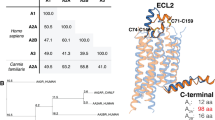Abstract.
Since 1990 it has been known that dimers are the basic functional form of nearly all G-protein-coupled receptors (GPCRs) and that homo- and heterodimerization may play a key role in correct receptor maturation and trafficking to the plasma membrane. Nevertheless, homo- and heterodimerization of GPCR has become a matter of debate especially in the search for the precise physiological meaning of this phenomenon. This article focuses on how heterodimerization of adenosine A1 and A2A receptors, which are coupled to apparently opposite signalling pathways, allows adenosine to exert a fine-tuning modulation of striatal glutamatergic neurotransmission, providing a switch mechanism by which low and high concentrations of adenosine inhibit and stimulate, respectively, glutamate release.
Similar content being viewed by others
Author information
Authors and Affiliations
Corresponding author
Additional information
Received 8 May 2006; received after revision 19 June 2006; accepted 17 July 2006
Rights and permissions
About this article
Cite this article
Ciruela, F., Ferré, S., Casadó, V. et al. Heterodimeric adenosine receptors: a device to regulate neurotransmitter release. Cell. Mol. Life Sci. 63, 2427–2431 (2006). https://doi.org/10.1007/s00018-006-6216-2
Published:
Issue Date:
DOI: https://doi.org/10.1007/s00018-006-6216-2




